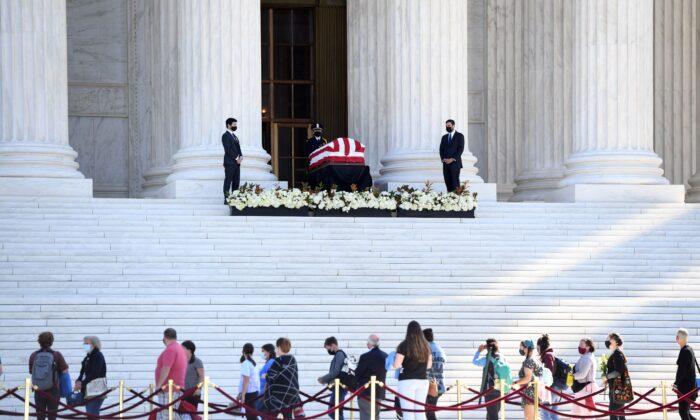Hundreds of people came to the Supreme Court to pay respects to the late Justice Ruth Bader Ginsburg. Mourners lined up outside the white marble building in Washington, where her flag-draped casket was placed after a private ceremony at the court’s Great Hall.
“Her voice in court and in our conference room was soft, but when she spoke, people listened,” said Chief Justice John Roberts during his speech at the Sept. 23 ceremony, after three days of tributes to Ginsburg, who passed less than six weeks after her 87th birthday.
In the 1950s, Ginsburg was one of the first women to attend Harvard Law School. When her husband got a job in New York, she transferred to Columbia Law School and graduated at the top of her class. Yet she was only offered a position of legal secretary due to skepticism about women in more senior legal positions at the time.
During her time at the American Civil Liberties Union in the 1970s, she argued against many statutes that favored either men or women, and successfully had them repealed as unconstitutional under the Equal Protection Clause.
She was appointed to the District of Columbia appeals court in 1980 by President Jimmy Carter and to the Supreme Court in 1993 by President Bill Clinton.
‘Mind Like a Steel Trap’
Ginsburg was “tough, brave, a fighter, a winner” but also “thoughtful, careful, compassionate, honest,” Roberts said.Despite her liberal leanings, she earned respect on both sides of the aisle.
“She was brilliant,” said Sen. Ted Cruz (R-Texas), who argued nine cases before the justice during his time as Texas Solicitor General.
Her questions “were always careful” and “incisive.”
“She was a dangerous questioner,” Cruz said.
Ginsburg on Sept. 25 will become the first woman to lie in state in the U.S. Capitol when her casket is placed in National Statuary Hall.
The Capitol held a similar ceremony for civil-rights pioneer Rosa Parks in 2005, but she lay “in honor,” as she didn’t hold government or military office.
Due to the pandemic, the Capitol ceremony will be limited to invited guests only, and at the courthouse, social distancing and face coverings will be required.
Dozens of her former clerks stood at attention when the casket arrived at the courthouse.
“On a personal level, she was such an amazing person. She had a mind like a steel trap,” said Jill Alexander, 59, whose husband served as a clerk for Ginsburg when she was an appeals court judge.
Ginsburg’s casket rested on the Lincoln catafalque, a pine board platform draped in black cloth that was used to support President Abraham Lincoln’s casket when he lay in state in the Capitol’s Rotunda after his assassination in 1865.
With the courthouse closed to the public, the justices are due to hear oral arguments by teleconference next month. Ginsburg’s courtroom chair and the bench in front of it were draped with black wool crepe to mark the occasion, a tradition that dates back at least to 1873. A black drape also hung over the courtroom doors.
Public viewing runs until 10 p.m. on Sept. 23 and between 9 a.m. until 10 p.m. on Sept. 24. A private interment service is planned for next week at Arlington National Cemetery. Ginsburg’s husband, Martin Ginsburg, was buried there in 2010.
Filling the Vacancy
Trump said he will announce on Sept. 26 his pick to fill Ginsburg’s seat. Senate GOP leaders have indicated they will have the votes to confirm the new justice, though several Republicans are expected to dissent.Ginsburg refused to retire when Democrats held the presidency from 2009 to 2017. Initially, she said President Barack Obama couldn’t appoint someone like her. Later, she pointed to the Republican-held Senate as a likely obstacle to Obama getting his most preferred pick.
Senate Republicans in 2016 refused to consider Obama’s nominee for another vacancy, a seat that ultimately went to Trump nominee Neil Gorsuch.
It may be up to the Supreme Court to ultimately resolve any legal disputes over the election results.





